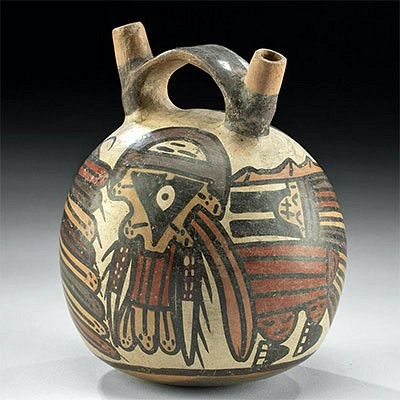Prehistoric Anasazi Chaco Pottery Duck Effigy Pitcher
Lot 98
About Seller
Artemis Fine Arts
686 S Taylor Ave, Ste 106
Louisville, CO 80027
United States
Selling antiquities, ancient and ethnographic art online since 1993, Artemis Gallery specializes in Classical Antiquities (Egyptian, Greek, Roman, Near Eastern), Asian, Pre-Columbian, African / Tribal / Oceanographic art. Our extensive inventory includes pottery, stone, metal, wood, glass and textil...Read more
Categories
Estimate:
$1,200 - $1,800
Absentee vs Live bid
Two ways to bid:
- Leave a max absentee bid and the platform will bid on your behalf up to your maximum bid during the live auction.
- Bid live during the auction and your bids will be submitted real-time to the auctioneer.
Bid Increments
| Price | Bid Increment |
|---|---|
| $0 | $25 |
| $300 | $50 |
| $1,000 | $100 |
| $2,000 | $250 |
| $5,000 | $500 |
| $10,000 | $1,000 |
| $20,000 | $2,500 |
| $50,000 | $5,000 |
| $100,000 | $10,000 |
| $200,000 | $20,000 |
About Auction
By Artemis Fine Arts
Feb 10, 2022
Set Reminder
2022-02-10 10:00:00
2022-02-10 10:00:00
America/New_York
Bidsquare
Bidsquare : Ancient & Ethnographic Art Through The Ages
https://www.bidsquare.com/auctions/artemis-gallery/ancient-ethnographic-art-through-the-ages-8873
Join us for Part Two of a spotlight on two fabulous collections, one from Lumberton, Texas, and the other from Whisnant Gallery in New Orleans. Artemis Fine Arts info@artemisgallery.com
Join us for Part Two of a spotlight on two fabulous collections, one from Lumberton, Texas, and the other from Whisnant Gallery in New Orleans. Artemis Fine Arts info@artemisgallery.com
- Lot Description
Native American, Southwestern United States, Ancestral Puebloan (Anasazi), Chaco, ca. 950 to 1200 CE. This is a remarkable effigy pitcher that is hand-built to resemble a bird. The elongated body rests on a rounded but stable base, and a rounded tail end projects upward from the body - reminiscent of a duck. An opening in the neck leads into the hollow interior and a ribbed handle connects the rim to the midsection, and two rounded protuberances flank the rim on either side of the handle. These knobs might have functioned as lugs for securing a lid or covering. The exterior is slipped in a white-gray pigment then decorated with linear motifs of triangles, wavy lines, and solid banding - that represent the folded wings and plumage of the bird. The piece is made using the coil and scrape method, to smooth the walls and then painted before firing. Size: 6" L x 4" W x 4.25" H (15.2 cm x 10.2 cm x 10.8 cm)
Provenance: private New Jersey, USA collection, purchased in 2001; ex-Cheryl S. Johnson and Fred Morrill collection
All items legal to buy/sell under U.S. Statute covering cultural patrimony Code 2600, CHAPTER 14, and are guaranteed to be as described or your money back.
A Certificate of Authenticity will accompany all winning bids.
PLEASE NOTE: Due to recent increases of shipments being seized by Australian & German customs (even for items with pre-UNESCO provenance), we will no longer ship most antiquities and ancient Chinese art to Australia & Germany. For categories of items that are acceptable to ship to Australia or Germany, please contact us directly or work with your local customs brokerage firm.
Display stands not described as included/custom in the item description are for photography purposes only and will not be included with the item upon shipping.
#169101Repaired and restored from over a dozen pieces. Break lines are visible, and a few are infilled with new material to fill gaps. Several pin hole perforations and losses along the break lines. Glue adhesive residue is visible on interior. Motifs are well preserved.Condition
- Shipping Info
-
All shipping is handled in-house for your convenience. Your invoice from Artemis Gallery will include shipping calculation instructions. If in doubt, please inquire BEFORE bidding for estimated shipping costs for individual items.
-
- Buyer's Premium



 EUR
EUR CAD
CAD AUD
AUD GBP
GBP MXN
MXN HKD
HKD CNY
CNY MYR
MYR SEK
SEK SGD
SGD CHF
CHF THB
THB















